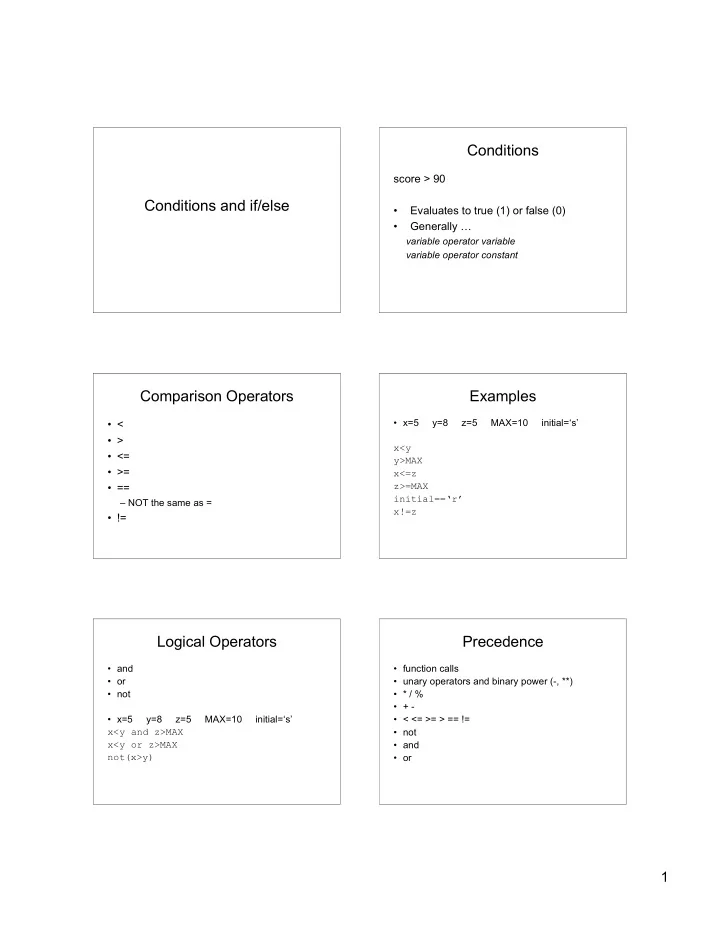

Conditions score > 90 Conditions and if/else • Evaluates to true (1) or false (0) • Generally … variable operator variable variable operator constant Comparison Operators Examples • x=5 y=8 z=5 MAX=10 initial=‘s’ • < • > x<y • <= y>MAX • >= x<=z z>=MAX • == initial==‘r’ – NOT the same as = x!=z • != Logical Operators Precedence • and • function calls • or • unary operators and binary power (-, **) • not • * / % • + - • x=5 y=8 z=5 MAX=10 initial=‘s’ • < <= >= > == != x<y and z>MAX • not x<y or z>MAX • and not(x>y) • or 1
Short-Circuit Evaluation Logical Assignment and Negation • Stop evaluation when true/false value is in_range = (x>0 and x<=10) # 1 if x between 1-10, 0 otherwise in_range = 0<x<=10 #Java does not allow this!!! determined same_initials = (first_initial==‘S’and last_initial==‘R’) • x=6 y=9 not_same_initials = not(first_initial==‘S’and last_initial==‘R’) not_same_initials = (first_initial!=‘S’ or last_initial!=‘R’) x>2 or y > 13 x<2 and y>13 DeMorgan’s Theorem Exercises 1. Determine the results of the following • not(a and b) => (not(a) or not(b)) statements given a=6 b=9 c=12 d=-7 e=0 f=12 : 1. print a > d • not(a or b) => (not(a) and not(b)) 2. print c <= f 3. print d > e 4. print c = f 5. print c == f 6. print c > b and e > f 7. print c > b or e > f 8. print a or e 9. print e and a if Statement if/else Statement if condition: • Statements MUST be indented statements else: if condition: statements statements if grade > 60: if age >= 16: print “You passed the class.” print “You can get a driver’s license.” print “Next up, CS112.” else: if age > 21: print “Sorry, you did not pass.” print “You can purchase alcohol.” print “Try again next semester.” print “You can gamble.” if age >= 16 and age < 21: print “You can drive but you cannot gamble.” 2
Nested if Statements Example if condition: if num > 0 and num <= 10: if condition: print “Your number is between 1 and 10” statement else: else: if num > 10: statement else: print “Your number is too high” statement else: print “Your number is too low” if grade > 60: print "You passed the class." if grade > 90: print "You passed with an A!" else: print "Sorry, you did not pass." Chained Conditionals Example if num > 0 and num <= 10: if grade > 60: print “Your number is between 1 and 10” print "You passed the class." else: if grade > 90: if num > 10: print "You passed with an A!" print “Your number is too high” else: else: print "Sorry, you did not pass.” print “Your number is too low” if num > 0 and num <= 10: #Does this work??? print “Your number is between 1 and 10” if grade > 60: elif num > 10: print "You passed the class." print “Your number is too high” elif grade > 90: else: print "You passed with an A!" print “Your number is too low” else: print "Sorry, you did not pass." Using Functions Exercises def getGrade(score): 1. Write an if statement that compares two integer if score > 90: variables x and y and prints the largest. For example, return “A” your program would print “X is larger than Y” or “Y is elif score > 80: larger than X”. return “B” 2. Modify your program above so that it compares three elif score > 70: integers x, y, and z and prints the largest. return “C” elif score > 60: 3. Write a function that takes as input a year and returns return “D” true if the year is a leap year and false otherwise. A else: year is a leap year if it is divisible by four, except that return “F” any year divisible by 100 is a leap year only if it is divisible by 400 as well. -Problem Solving and Program Design in C Hanly and Koffman 3
Recommend
More recommend